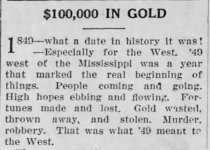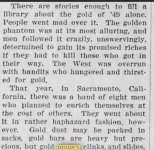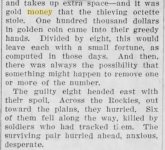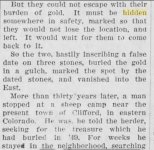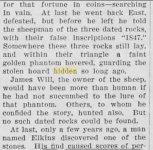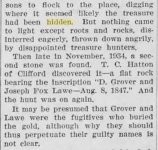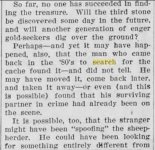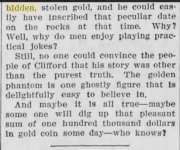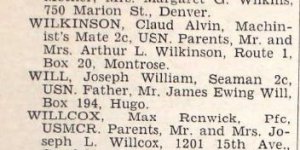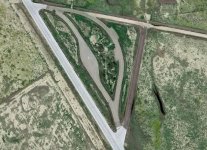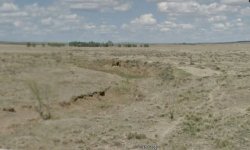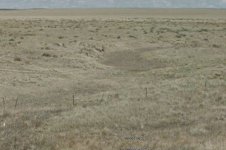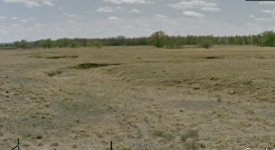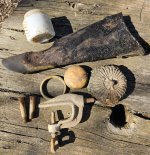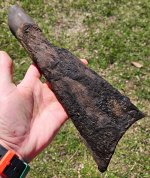You are using an out of date browser. It may not display this or other websites correctly.
You should upgrade or use an alternative browser.
You should upgrade or use an alternative browser.
$100,000 in Gold 1849
- Thread starter jeff of pa
- Start date
alaskaseeker
Sr. Member
Interesting story.....
Samanthy
Full Member
- Apr 22, 2018
- 219
- 251
- Detector(s) used
-
White‘s Sierra Madre
White‘s TM–600
- Primary Interest:
- Cache Hunting
I think the story would be more believable if it had appeared in a local newspaper in Colorado.
Hillbilly Prince
Silver Member
- Aug 9, 2018
- 4,999
- 12,712
- Detector(s) used
- Garrett All Terrain Pro
- Primary Interest:
- All Treasure Hunting
Guy waits thirty years to return?
Shiloh1
Jr. Member
- Mar 9, 2009
- 78
- 18
- Detector(s) used
- Garrett GTI 2500
- Primary Interest:
- All Treasure Hunting
My thought on the story is that it is made up to sell news papers. If you notice there are no state, towns, cities, landmarks listed to go by. Only stories of people that had an interest in the treasure. The west is a very big place.
KANACKI
Bronze Member
- Mar 1, 2015
- 1,445
- 5,927
- Primary Interest:
- All Treasure Hunting
Thanks Jeff I love these stories. Many of course are just stories. And some interesting points have been made. However these stories should be written off too quickly.
For example the town of Clifford is now a ghost town.
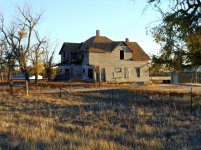
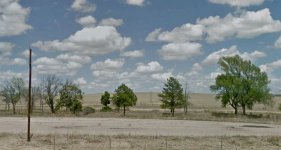
All the names mentioned in the above newspaper story are real. In the 1920 census there was 132 people living there.
James wills was a farmer as well as E Lee Elkins and Thomas Hatton was farmers around Clifford. By the 1930 Clifford was abandoned and they moved to Hugo a few miles away. But still by 1930 conducted farming activity there.
James will 1920 census below

E Lee Elkins 120 census below

Thomas Hatton 1920 census below.

If the story was just fake story? The the fake story was woven around real people?
Yet it may be possible to trace the land each of the 3 mention above to triangulate a search area.
Kanacki
For example the town of Clifford is now a ghost town.


All the names mentioned in the above newspaper story are real. In the 1920 census there was 132 people living there.
James wills was a farmer as well as E Lee Elkins and Thomas Hatton was farmers around Clifford. By the 1930 Clifford was abandoned and they moved to Hugo a few miles away. But still by 1930 conducted farming activity there.
James will 1920 census below

E Lee Elkins 120 census below

Thomas Hatton 1920 census below.

If the story was just fake story? The the fake story was woven around real people?
Yet it may be possible to trace the land each of the 3 mention above to triangulate a search area.
Kanacki
KANACKI
Bronze Member
- Mar 1, 2015
- 1,445
- 5,927
- Primary Interest:
- All Treasure Hunting
The date on stone was perhaps not the date of the robbery but a birth date?
Interesting enough in the Michigan, Deaths and Burials Index, 1867-1995 DEATH, BURIAL, CEMETERY & OBITUARIES
There was a Joseph F. Lawe whose birth date Birth was about 1847? His Birth Place:New York His Death Date: 28 Feb 1878 Place of Death Kalamazoo, Kalamazoo, Michigan.
Death Age: 31 Occupation: Farmer Race: White Marital status: Married Gender: Male
FHL Film Number: 984130
This is the only record of a possible Joseph Fox Lawe coincidence perhaps? But have a birth date matching exactly to the date written on the stone?
Kanacki
Interesting enough in the Michigan, Deaths and Burials Index, 1867-1995 DEATH, BURIAL, CEMETERY & OBITUARIES
There was a Joseph F. Lawe whose birth date Birth was about 1847? His Birth Place:New York His Death Date: 28 Feb 1878 Place of Death Kalamazoo, Kalamazoo, Michigan.
Death Age: 31 Occupation: Farmer Race: White Marital status: Married Gender: Male
FHL Film Number: 984130
This is the only record of a possible Joseph Fox Lawe coincidence perhaps? But have a birth date matching exactly to the date written on the stone?
Kanacki
ARC
Gold Member
- Aug 19, 2014
- 37,234
- 131,472
- Detector(s) used
- JW 8X-ML X2-VP 585
- Primary Interest:
- All Treasure Hunting
I don't know about anyone else... But if I had the opportunity I would detect the entire town of Clifford.
The info of the town and Kanacki's pictures invokes a serious "urge"... Even if treasure story was fake. heh
The info of the town and Kanacki's pictures invokes a serious "urge"... Even if treasure story was fake. heh
KANACKI
Bronze Member
- Mar 1, 2015
- 1,445
- 5,927
- Primary Interest:
- All Treasure Hunting
Hello AARC
It would be worthwhile just to detect the foundations of the ghost town of Clifford in itself. as you can see there are still foundations of some of houses. The town according with 1920 census had a 132 people living there. Its downfall began in 1930's with the great depression and the drought that created the great dust storms of the middle of the decade of the 1930's. Rural poverty was at its worst in the region.
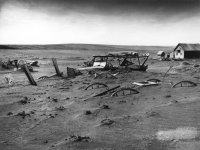
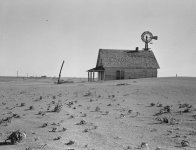
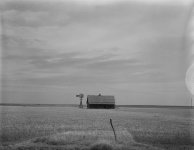
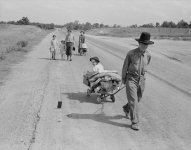

The pictures above illustrates the tough time facing people people in Clifford. Most residents moved away many of farmers moved to nearby town of Hugo by the mid 1930s . All 3 farmers was only tenant farmers so in times of adversity they would of suffered terribly.
Kanacki
It would be worthwhile just to detect the foundations of the ghost town of Clifford in itself. as you can see there are still foundations of some of houses. The town according with 1920 census had a 132 people living there. Its downfall began in 1930's with the great depression and the drought that created the great dust storms of the middle of the decade of the 1930's. Rural poverty was at its worst in the region.





The pictures above illustrates the tough time facing people people in Clifford. Most residents moved away many of farmers moved to nearby town of Hugo by the mid 1930s . All 3 farmers was only tenant farmers so in times of adversity they would of suffered terribly.
Kanacki
ARC
Gold Member
- Aug 19, 2014
- 37,234
- 131,472
- Detector(s) used
- JW 8X-ML X2-VP 585
- Primary Interest:
- All Treasure Hunting
I think just in iron artifacts alone it would be worth it.
There was a time when this place was doing good and those drops prolly still exist simply due to the fact everyone else thinks "there's nothing there".
See...
I think outside
There was a time when this place was doing good and those drops prolly still exist simply due to the fact everyone else thinks "there's nothing there".
See...
I think outside

KANACKI
Bronze Member
- Mar 1, 2015
- 1,445
- 5,927
- Primary Interest:
- All Treasure Hunting
While the story was published in 1935 at beginning of the great dust bowl in 1935. Other newspaper stories speculated that the man Wills met was just spinning a yarn. But when stones was found it seems a little more to the story which to have appeared in the 1920's. If Wills had met this man searching for these stone markers who told him at the time the money was buried 30 years about that would place the date of the robbery at a much latter date? Around the decade of the 1870's. Wills has been recorded as a farmer from at least 1913. We are not sure the exact date wills met this man?
In keeping an open mind on the context of the story here is another newspaper story. Strange enough the story made it all the way to Australia.

Kanacki
In keeping an open mind on the context of the story here is another newspaper story. Strange enough the story made it all the way to Australia.

Kanacki
KANACKI
Bronze Member
- Mar 1, 2015
- 1,445
- 5,927
- Primary Interest:
- All Treasure Hunting
Hello AARC
Here is a very rough estimate of 3 farms. Banking on the fact the three farmers had land next each other and each stione of been in line of site to be of any use. We could possibly calculate a rough idea what gulches this alleged coins are buried? Given the very nature of the ground gulches are ravines made by water channels. It is possible that in one of these gulches that traverses the property that money might be still hidden?
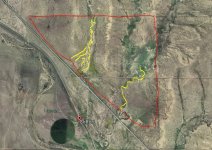
Admittedly it is still a large search area. But due to the nature of such channels perhaps the coins are close enough to the surface to be picked up by a metal detector?
And factor to considering the 1930;s Lincoln county was several affect but dust storms stripping away soil that was most likely why the stone was uncovered. You see map below of states and county affected by dust storms.
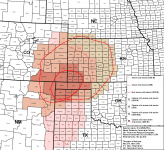
Kanacki
Here is a very rough estimate of 3 farms. Banking on the fact the three farmers had land next each other and each stione of been in line of site to be of any use. We could possibly calculate a rough idea what gulches this alleged coins are buried? Given the very nature of the ground gulches are ravines made by water channels. It is possible that in one of these gulches that traverses the property that money might be still hidden?

Admittedly it is still a large search area. But due to the nature of such channels perhaps the coins are close enough to the surface to be picked up by a metal detector?
And factor to considering the 1930;s Lincoln county was several affect but dust storms stripping away soil that was most likely why the stone was uncovered. You see map below of states and county affected by dust storms.

Kanacki
KANACKI
Bronze Member
- Mar 1, 2015
- 1,445
- 5,927
- Primary Interest:
- All Treasure Hunting
KANACKI
Bronze Member
- Mar 1, 2015
- 1,445
- 5,927
- Primary Interest:
- All Treasure Hunting
KANACKI
Bronze Member
- Mar 1, 2015
- 1,445
- 5,927
- Primary Interest:
- All Treasure Hunting
Here is another version of the story.
One reported treasure was buried in 1862 by a gang of bandits who stole more than $100,000 in army payroll money. As with most treasure tales, this story has many versions, including the one that follows.
These robbers were already notorious for crimes they had committed in Sacramento, California, in 1847. By 1862, though, they had moved to eastern Colorado and were livingquiet lives as farmers, sheepherders, or cattle ranchers. Still, they decided to join together for one last robbery: a poorly guarded U.S. Army payroll headed for Denver. They planned their final robbery carefully, intending to divide the money and head east, most likely to Chicago.
Their plans were ruined, however, when they found that the stagecoach was accompanied by four armed guards. They grabbed the payroll, but only two of the gang survived the shoot-out and they were quickly pursued by a posse. Rather than travel with such a heavy quantity of gold coins, the two robbers decided to bury them. A few miles east of Clifford, Colorado, they dug three shallow trenches in a circular formation. They filled the trenches and packed the earth on top to make it look as if three people had been buried in shallow graves. A rock resembling a tombstone was placed on each mound. On two of the stones, they chiseled their names and the date "1847." They carved the word "unknown" on the third stone. Exactly why they went to the trouble of preparing three graves is unknown, but perhaps they hoped that the posse would think they had been killed in a gunfight. Finally, at the center of the circle, they dug a large hole in which they buried their loot in three Dutch ovens. Then they departed.
No one would ever have known about the treasure if a stranger from Chicago had not come to Clifford in 1884 and found a place to stay with sheep rancher James Will. The man spent most of his time walking through the barren prairie east of town. When he could not find whatever he was looking for, he related the story of the payroll robbery and the two surviving bandits to James Will and left town for good.
Neither Will nor most of Clifford's residents put much stock into the tale — until May 1931, when George Elkins found a stone inscribed "1847"; some words also seemed to be carved in the stone, but exposure to the elements had made them illegible. Treasure seekers dug far and wide but did not discover any cache — or the other two stones — in the area.
However, in November 1934, another stone was found by Tom Hatton. This stone read: "D. Grover and Joseph Fox-Lawe — Aug. 8, 1847." People assumed that these were the names of the two robbers, but more treasure hunting did not turn up the gold.
Although one of the robbers may have returned and found the money, many people believe that the stolen payroll is still buried near Clifford. According to author Perry Eberhart, who has written about the cache, a careful treasure hunter might find the metal pots containing a fortune in gold on one of the hills that lie east of Clifford.
Kanacki
One reported treasure was buried in 1862 by a gang of bandits who stole more than $100,000 in army payroll money. As with most treasure tales, this story has many versions, including the one that follows.
These robbers were already notorious for crimes they had committed in Sacramento, California, in 1847. By 1862, though, they had moved to eastern Colorado and were livingquiet lives as farmers, sheepherders, or cattle ranchers. Still, they decided to join together for one last robbery: a poorly guarded U.S. Army payroll headed for Denver. They planned their final robbery carefully, intending to divide the money and head east, most likely to Chicago.
Their plans were ruined, however, when they found that the stagecoach was accompanied by four armed guards. They grabbed the payroll, but only two of the gang survived the shoot-out and they were quickly pursued by a posse. Rather than travel with such a heavy quantity of gold coins, the two robbers decided to bury them. A few miles east of Clifford, Colorado, they dug three shallow trenches in a circular formation. They filled the trenches and packed the earth on top to make it look as if three people had been buried in shallow graves. A rock resembling a tombstone was placed on each mound. On two of the stones, they chiseled their names and the date "1847." They carved the word "unknown" on the third stone. Exactly why they went to the trouble of preparing three graves is unknown, but perhaps they hoped that the posse would think they had been killed in a gunfight. Finally, at the center of the circle, they dug a large hole in which they buried their loot in three Dutch ovens. Then they departed.
No one would ever have known about the treasure if a stranger from Chicago had not come to Clifford in 1884 and found a place to stay with sheep rancher James Will. The man spent most of his time walking through the barren prairie east of town. When he could not find whatever he was looking for, he related the story of the payroll robbery and the two surviving bandits to James Will and left town for good.
Neither Will nor most of Clifford's residents put much stock into the tale — until May 1931, when George Elkins found a stone inscribed "1847"; some words also seemed to be carved in the stone, but exposure to the elements had made them illegible. Treasure seekers dug far and wide but did not discover any cache — or the other two stones — in the area.
However, in November 1934, another stone was found by Tom Hatton. This stone read: "D. Grover and Joseph Fox-Lawe — Aug. 8, 1847." People assumed that these were the names of the two robbers, but more treasure hunting did not turn up the gold.
Although one of the robbers may have returned and found the money, many people believe that the stolen payroll is still buried near Clifford. According to author Perry Eberhart, who has written about the cache, a careful treasure hunter might find the metal pots containing a fortune in gold on one of the hills that lie east of Clifford.
Kanacki
KANACKI
Bronze Member
- Mar 1, 2015
- 1,445
- 5,927
- Primary Interest:
- All Treasure Hunting
Here is another version of the story.
One reported treasure was buried in 1862 by a gang of bandits who stole more than $100,000 in army payroll money. As with most treasure tales, this story has many versions, including the one that follows.
These robbers were already notorious for crimes they had committed in Sacramento, California, in 1847. By 1862, though, they had moved to eastern Colorado and were livingquiet lives as farmers, sheepherders, or cattle ranchers. Still, they decided to join together for one last robbery: a poorly guarded U.S. Army payroll headed for Denver. They planned their final robbery carefully, intending to divide the money and head east, most likely to Chicago.
Their plans were ruined, however, when they found that the stagecoach was accompanied by four armed guards. They grabbed the payroll, but only two of the gang survived the shoot-out and they were quickly pursued by a posse. Rather than travel with such a heavy quantity of gold coins, the two robbers decided to bury them. A few miles east of Clifford, Colorado, they dug three shallow trenches in a circular formation. They filled the trenches and packed the earth on top to make it look as if three people had been buried in shallow graves. A rock resembling a tombstone was placed on each mound. On two of the stones, they chiseled their names and the date "1847." They carved the word "unknown" on the third stone. Exactly why they went to the trouble of preparing three graves is unknown, but perhaps they hoped that the posse would think they had been killed in a gunfight. Finally, at the center of the circle, they dug a large hole in which they buried their loot in three Dutch ovens. Then they departed.
No one would ever have known about the treasure if a stranger from Chicago had not come to Clifford in 1884 and found a place to stay with sheep rancher James Will. The man spent most of his time walking through the barren prairie east of town. When he could not find whatever he was looking for, he related the story of the payroll robbery and the two surviving bandits to James Will and left town for good.
Neither Will nor most of Clifford's residents put much stock into the tale — until May 1931, when George Elkins found a stone inscribed "1847"; some words also seemed to be carved in the stone, but exposure to the elements had made them illegible. Treasure seekers dug far and wide but did not discover any cache — or the other two stones — in the area.
However, in November 1934, another stone was found by Tom Hatton. This stone read: "D. Grover and Joseph Fox-Lawe — Aug. 8, 1847." People assumed that these were the names of the two robbers, but more treasure hunting did not turn up the gold.
Although one of the robbers may have returned and found the money, many people believe that the stolen payroll is still buried near Clifford. According to author Perry Eberhart, who has written about the cache, a careful treasure hunter might find the metal pots containing a fortune in gold on one of the hills that lie east of Clifford.
Kanacki
Clearly one has sort out the actual errors in this alleged treasure story? Both story version have glaring errors.
James Will was 50 in 1930 so he was born in 1880. He was born in England so any encounter before that date is purely in the zone of fantasy.
Kanacki
KANACKI
Bronze Member
- Mar 1, 2015
- 1,445
- 5,927
- Primary Interest:
- All Treasure Hunting
The facts to date.
1. the hamlet of Clifford existed.
2. James Will existed.
3. Elkins existed.
4. Thomas Hatton Existed.
5. There was a record of Joseph Fox-Lawe who coincidental was born in 1847 the same date marked on the stone.
All other aspects of story are at this stage speculation. We have two versions of this alleged treasure of gold coins. 1847 cannot be the year of this alleged robbery because The California Gold Rush was a gold rush that began on January 24, 1848, when gold was found by James W. Marshall at Sutter's Mill in Coloma, California. The news of gold brought approximately 300,000 people to California from the rest of the United States and abroad. gold coins was in short supply at the time.
$100000 is an ungodly sum of money for the era.
As for it being an alleged army payroll how come there never seems to be records of these alleged payroll thefts? clearly the original story over time has been polluted with assumptions to make the story more dramatic. In searching through all newspaper reports I have not come across any record with that amount of gold coin alleged to be stolen.
With so many key aspects of the story incorrect and improbable then we must consider the who story was originally a hoax that got out of hand over time. Since James Wills was the likely perpetrator and now long dead we will never know for sure? But perhaps most of all we should appreciate the lesson it in gives in regards to how treasure legends can evolve.
Kanacki
1. the hamlet of Clifford existed.
2. James Will existed.
3. Elkins existed.
4. Thomas Hatton Existed.
5. There was a record of Joseph Fox-Lawe who coincidental was born in 1847 the same date marked on the stone.
All other aspects of story are at this stage speculation. We have two versions of this alleged treasure of gold coins. 1847 cannot be the year of this alleged robbery because The California Gold Rush was a gold rush that began on January 24, 1848, when gold was found by James W. Marshall at Sutter's Mill in Coloma, California. The news of gold brought approximately 300,000 people to California from the rest of the United States and abroad. gold coins was in short supply at the time.
$100000 is an ungodly sum of money for the era.
As for it being an alleged army payroll how come there never seems to be records of these alleged payroll thefts? clearly the original story over time has been polluted with assumptions to make the story more dramatic. In searching through all newspaper reports I have not come across any record with that amount of gold coin alleged to be stolen.
With so many key aspects of the story incorrect and improbable then we must consider the who story was originally a hoax that got out of hand over time. Since James Wills was the likely perpetrator and now long dead we will never know for sure? But perhaps most of all we should appreciate the lesson it in gives in regards to how treasure legends can evolve.
Kanacki
Last edited:
Top Member Reactions
-
 2605
2605 -
 1156
1156 -
 1047
1047 -
 892
892 -
 874
874 -
 848
848 -
 787
787 -
 675
675 -
 659
659 -
 642
642 -
 494
494 -
 472
472 -
 467
467 -
 465
465 -
 459
459 -
 432
432 -
 415
415 -
 408
408 -
O
401
-
 389
389
Users who are viewing this thread
Total: 2 (members: 0, guests: 2)
Latest Discussions
-
-
"GLORY DAYS" for Ol' timers thread... let's have fun & share..!
- Latest: Bucket Lister
-
-
-
-


